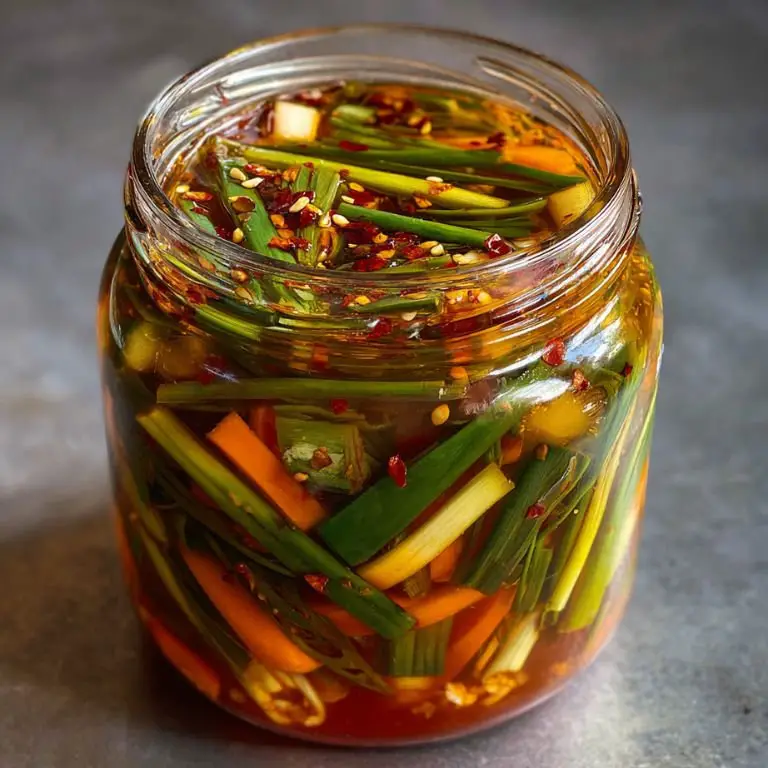If you're into bold, crunchy, and umami-rich condiments, you're going to love these Korean garlic chive pickles with chili flakes and rice vinegar. This isn’t your average jar of pickles—this is a punchy, garlicky, slightly spicy flavor bomb that elevates any meal. Whether you're into Korean cabbage recipes or looking for a twist on traditional cucumber kimchi recipe Korean style, this garlic chive pickle adds serious flair to your table of Korean side dishes. It's quick to make, keeps well in the fridge, and fits perfectly into your collection of Asian pickles or even broader pickled recipes from around the globe.
Zingy Korean Garlic Chive Pickles with Chili Flakes and Rice Vinegar
Prep Time 20 minutes mins
Cook Time 5 minutes mins
Total Time 25 minutes mins
Course Condiment, Side Dish
Cuisine Korean
Glass jar or airtight container (32 oz or larger) Wide-mouth jars are best for layering the vegetables and allowing the brine to circulate evenly.
Sharp knife and cutting board For slicing radish, garlic chives, and carrots cleanly.
Medium saucepan For preparing the brine.
Mixing bowl To toss vegetables with chili flakes before jarring.
Alternatives
Mandoline slicer Speeds up julienning radish and carrots if you prefer paper-thin texture.
Fermentation jar with weight and airlock Optional for those wanting a lightly fermented twist on this pickle.
For the Pickles
- 2 large bunches of garlic chives roughly 200g, rinsed and cut into 2-inch lengths
- 1 small Korean radish or daikon peeled and cut into matchsticks (can sub in turnip or watermelon radish)
- 1 small carrot peeled and julienned (adds crunch and color)
- 2 garlic cloves thinly sliced
- 2 tablespoons Korean chili flakes gochugaru
- 1 teaspoon toasted sesame seeds optional but highly recommended for texture
For the Pickling Brine
- 1 cup rice vinegar
- 1/2 cup water
- 1/4 cup sugar
- 1 tablespoon salt
- 1 tablespoon fish sauce or soy sauce for a vegan version
Prepare the Vegetables
Wash and trim the garlic chives, cutting them into roughly 2-inch lengths. Peel and julienne the Korean radish and carrot. Thinly slice the garlic. Place all the vegetables in a large mixing bowl.
Add the Chili Flakes
Sprinkle the gochugaru (Korean chili flakes) over the vegetables and toss gently to coat. This step not only gives your pickles their signature spicy red hue but also infuses them with that smoky, fermented-like depth characteristic of many korean pickles.
Make the Pickling Brine
In a medium saucepan, combine rice vinegar, water, sugar, salt, and fish sauce. Bring to a light simmer, stirring until the sugar and salt dissolve completely. Remove from heat and let cool to room temperature. You don’t want to pour hot brine over the veggies as it can wilt them too much.
Jar the Vegetables
Pack the chili-flake-tossed vegetables into a clean glass jar. Use a spoon to tamp them down gently, creating space for the brine to seep through all the layers.
Pour the Brine
Once the brine is cooled, pour it over the packed vegetables, making sure everything is submerged. Tap the jar on the counter gently to release any air bubbles.
Seal and Chill
Seal the jar tightly and refrigerate. Let the pickles sit for at least 24 hours before eating, but they taste best after 2–3 days as the flavors meld and deepen.
Pairings
These Korean garlic chive pickles shine as part of any Korean meal. Serve them alongside:
- Grilled bulgogi or spicy pork belly – Their acidic tang cuts through the richness of fatty meats.
- Bibimbap or rice bowls – Toss them in for a crunchy contrast.
- Savory pancakes (pajeon) – Especially those made with scallions or seafood.
- Sandwiches and wraps – Add a spoonful to bánh mì-style sandwiches or Korean-inspired lettuce wraps.
- Korean-style fried chicken – Like pickled radishes, they offer the perfect cooldown between bites of spicy wings.
They also pair beautifully with other asian pickled vegetables, including vietnamese pickled vegetables or even more delicate japanese pickled cucumbers. It’s a versatile side that adds dimension to a variety of meals.
Frequently Asked Questions
1. Can I use other vegetables besides garlic chives and radish?
Absolutely. Try thinly sliced cucumbers (to create a variation akin to a korean pickled cucumber or pickled cucumber recipe), napa cabbage, or even scallions. The brine works well with almost any firm vegetable.
2. Do I have to use Korean chili flakes?
For the most authentic flavor, gochugaru is ideal—it has a mild, smoky heat unlike any other chili. However, you can substitute with a blend of smoked paprika and a touch of cayenne in a pinch.
3. How long will these pickles keep?
Stored in the refrigerator in a clean, airtight jar, these pickles will last about 2–3 weeks. The flavors may intensify over time, and the vegetables will soften slightly the longer they sit.
4. Can I ferment this instead of quick-pickling?
Yes! Omit the vinegar and sugar, and instead add a bit more salt (2 tablespoons total). Leave the jar at room temperature for 2–3 days, then refrigerate. You’ll get a funkier, fermented result more like traditional kimchi or other fermented korean pickles.
5. Are these similar to pickled radishes or cucumber kimchi?
Yes, but milder. Think of them as a cousin to pickled radishes Korean style or a less pungent version of cucumber kimchi recipe Korean in origin. They bring the tang and heat without the intensity of fermentation, making them great for first-time pickle makers.
